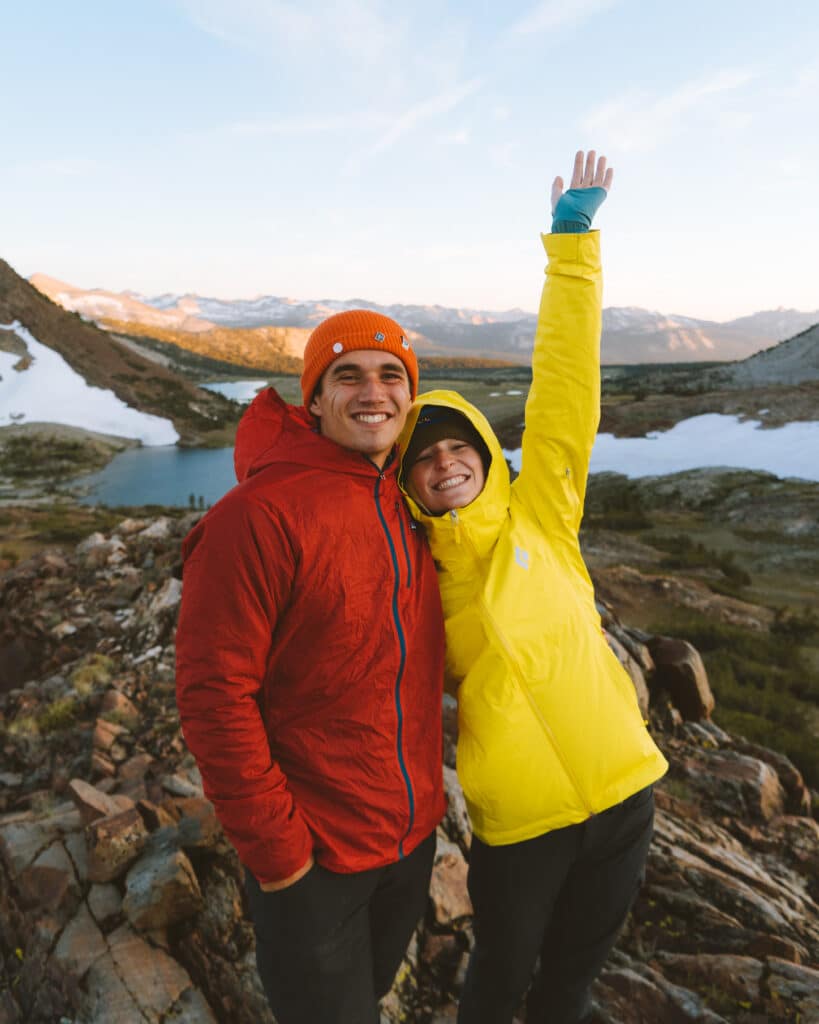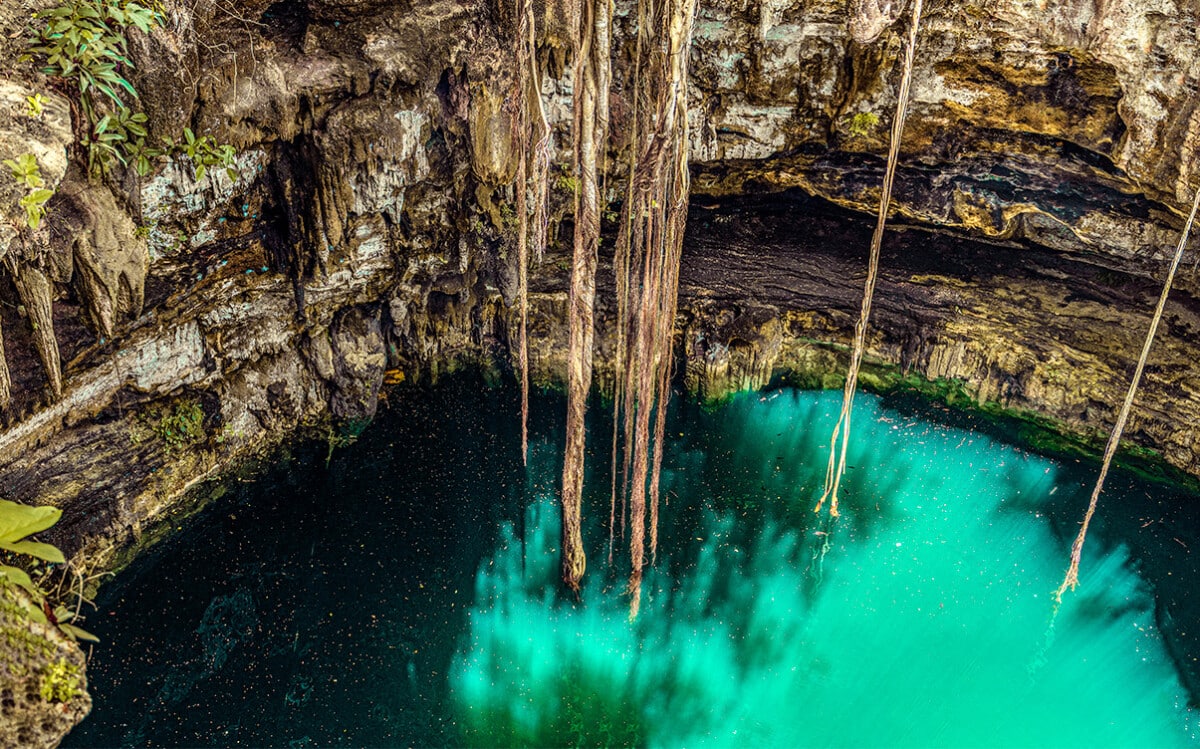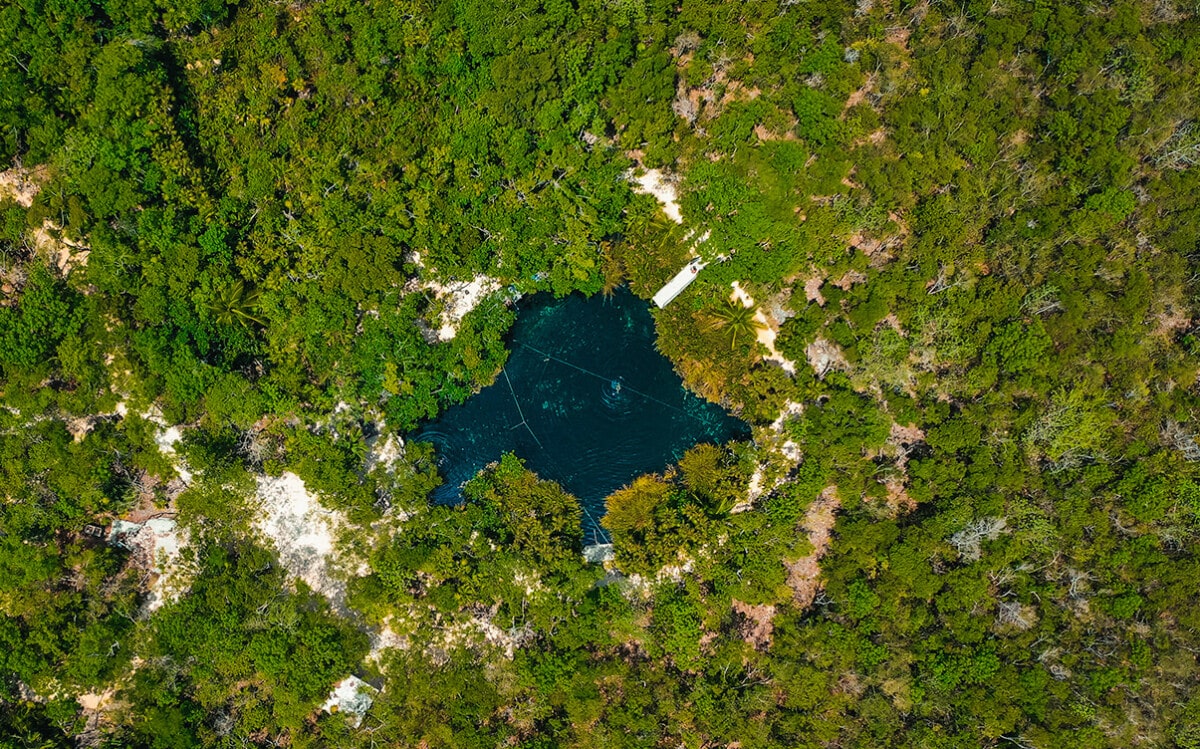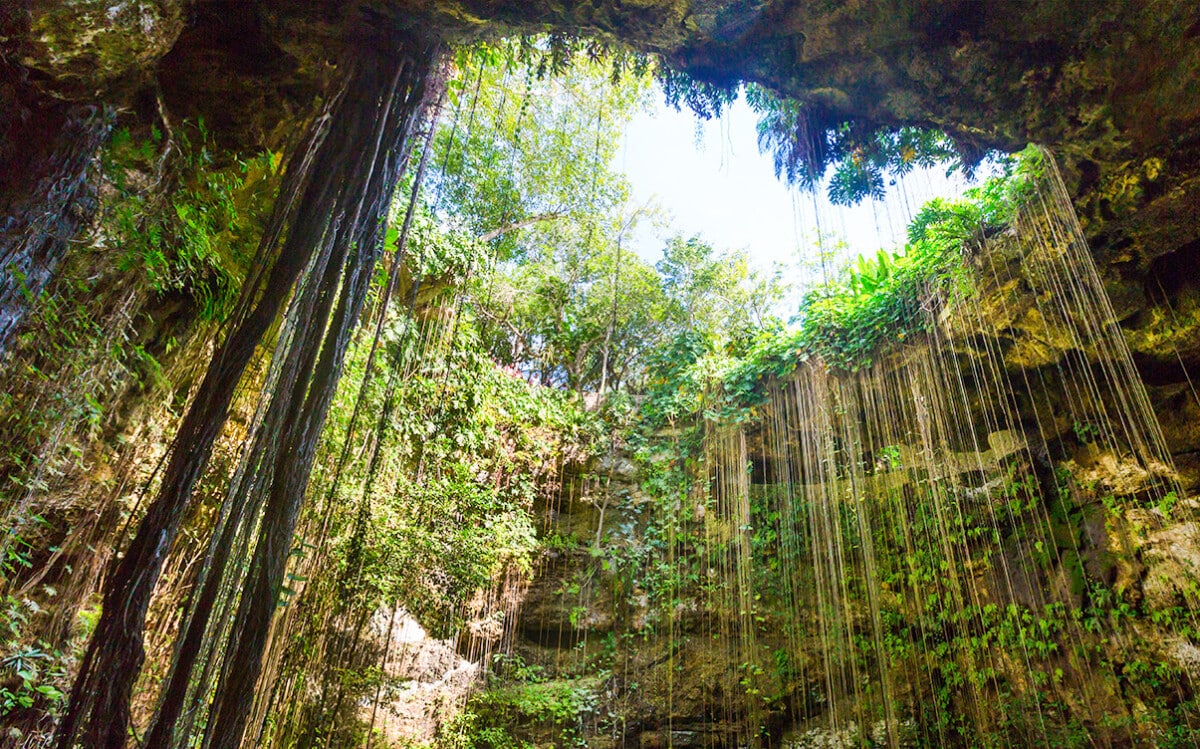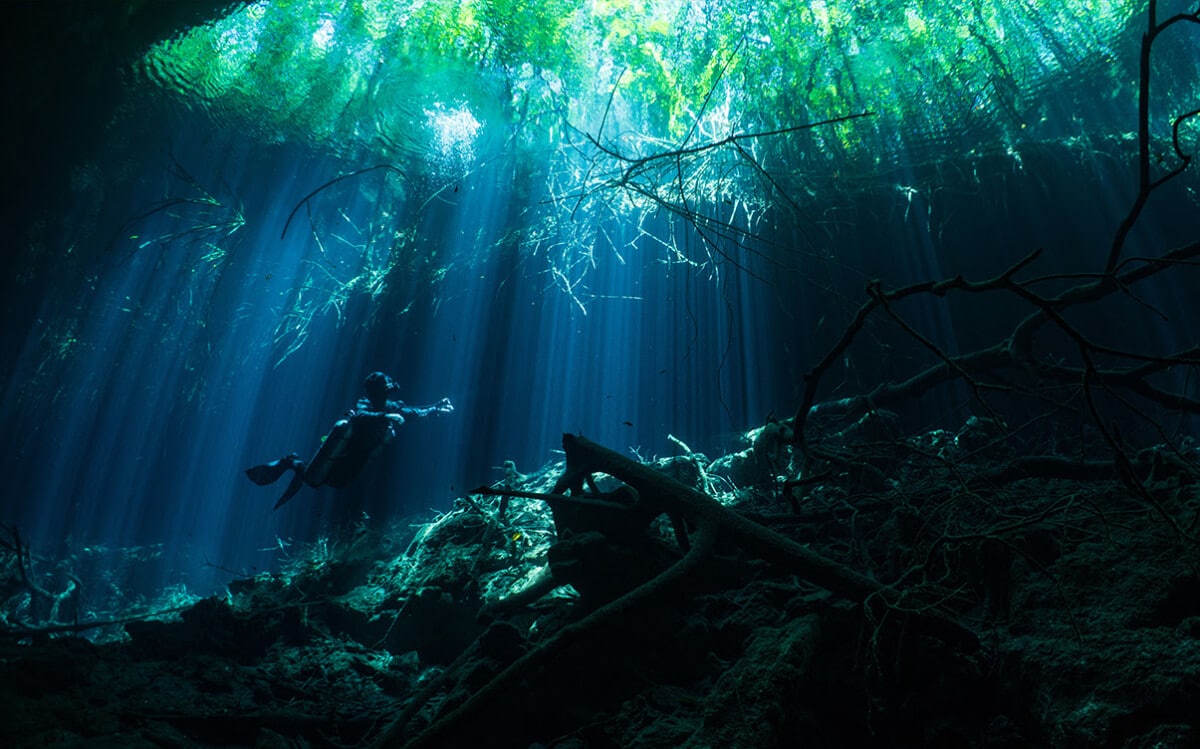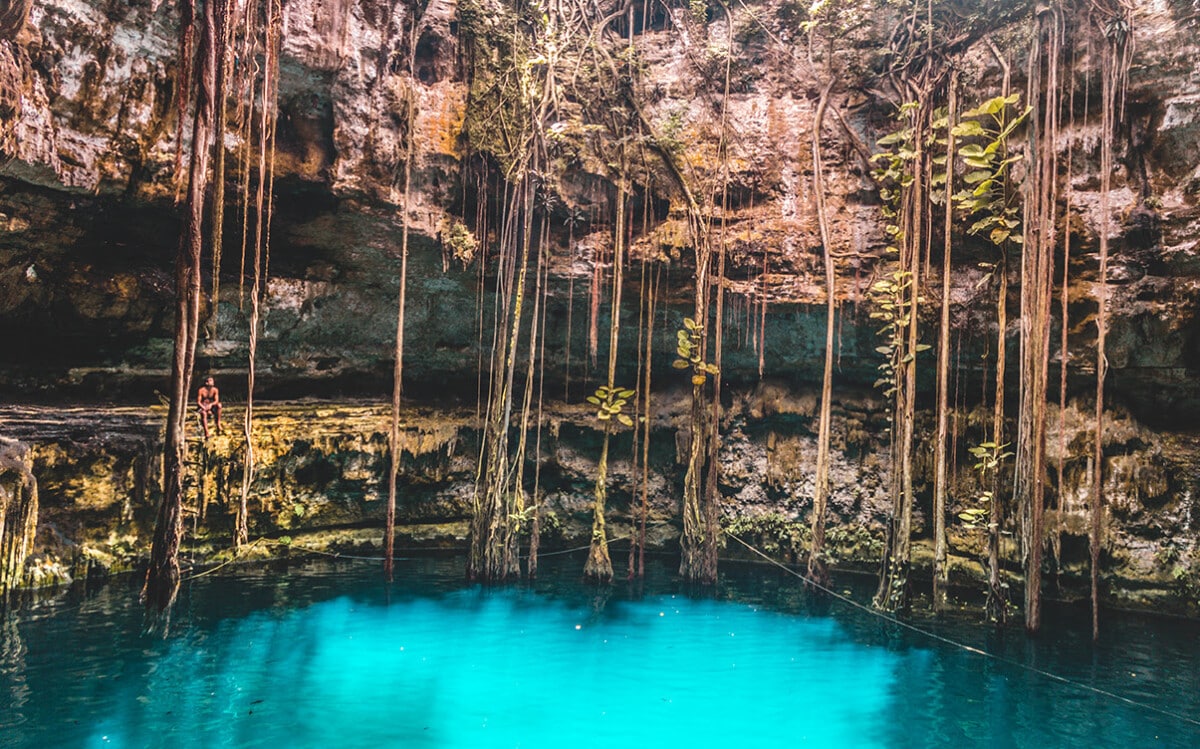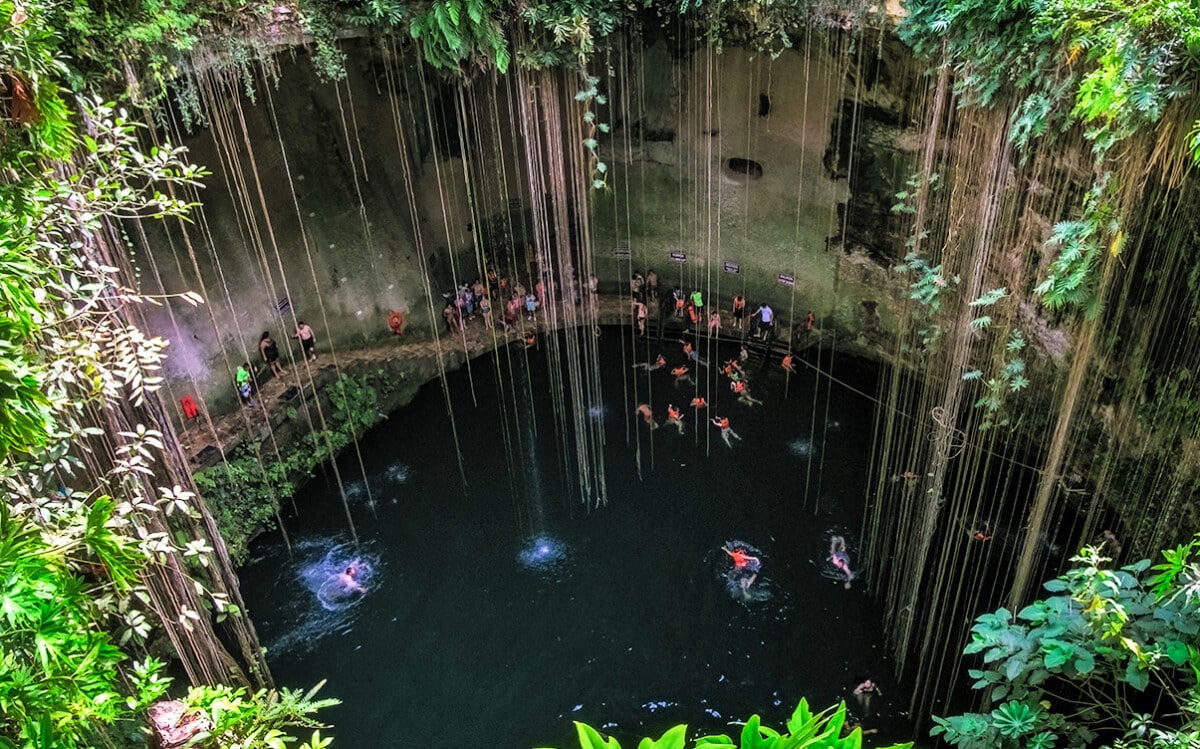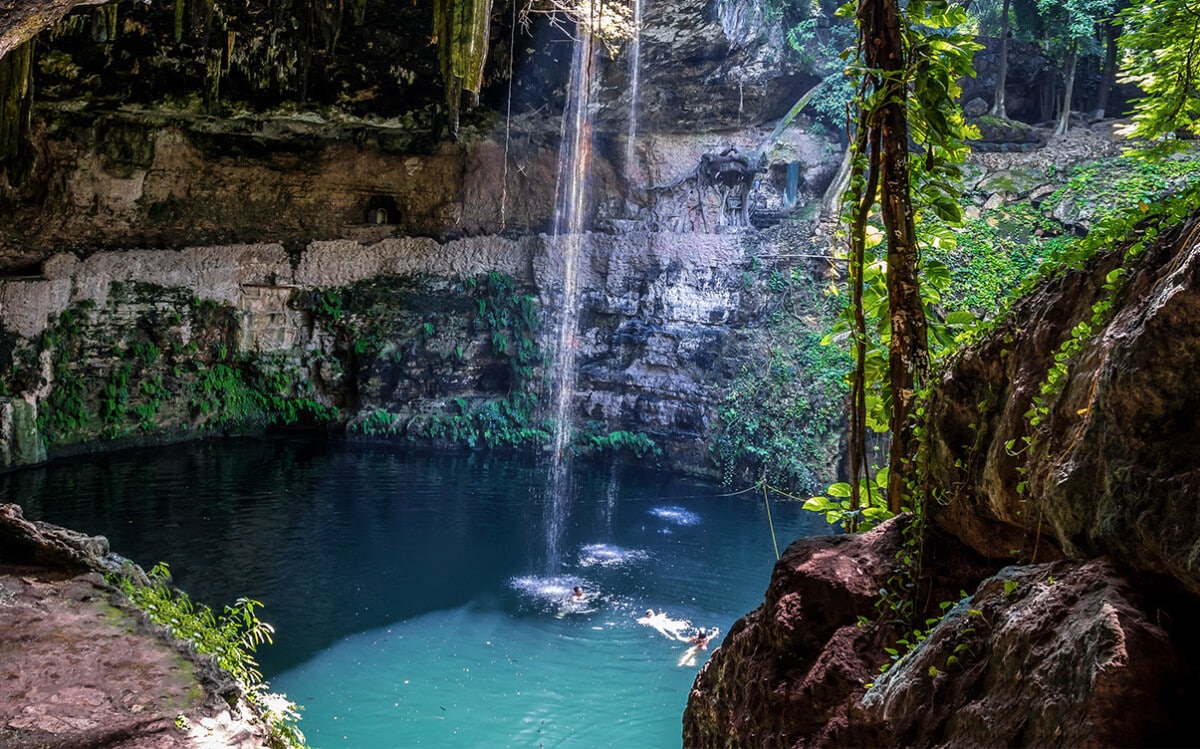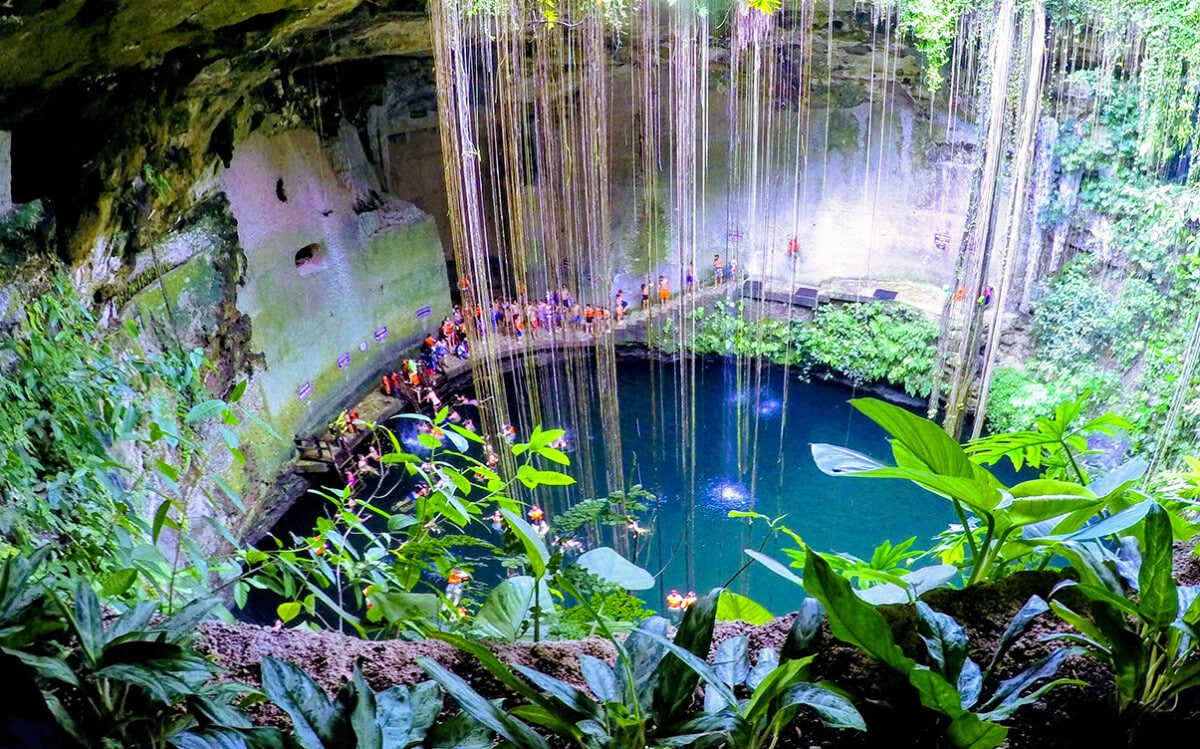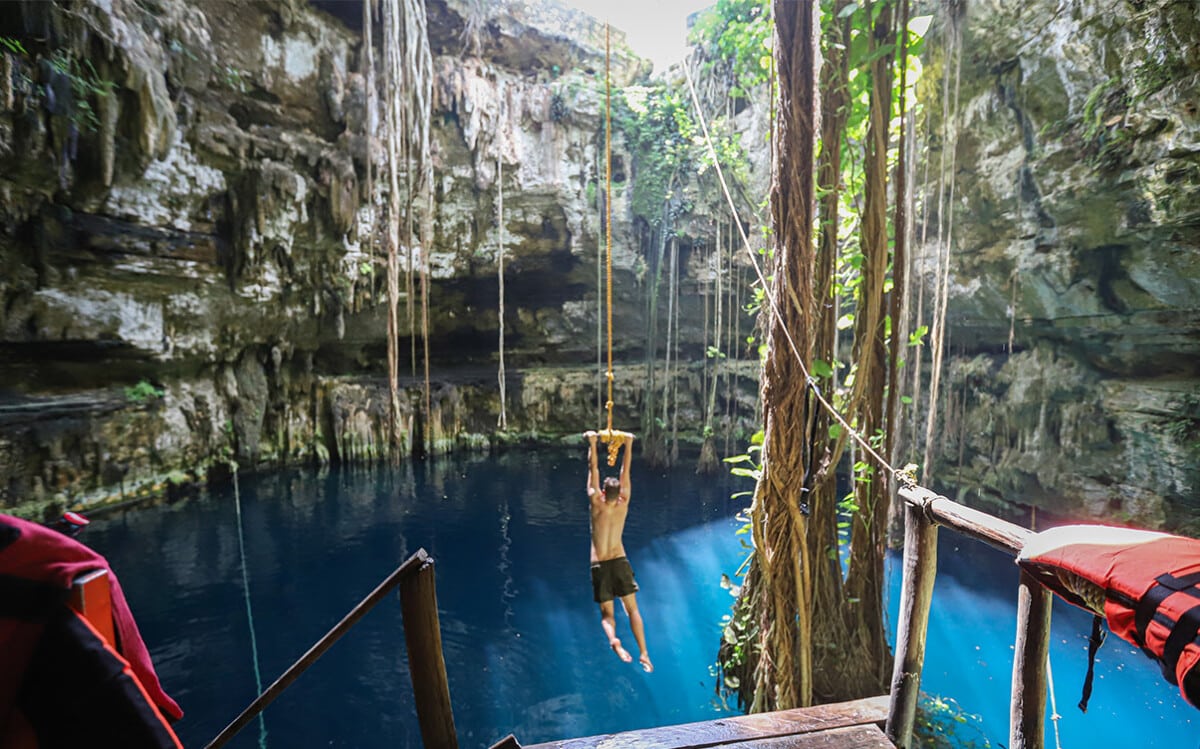What Are Cenotes and How Can You Visit Them in Cancun?
Disclaimer: This post may contain affiliate links. Please see our Disclosure Policy and Advertiser Disclosure for details.
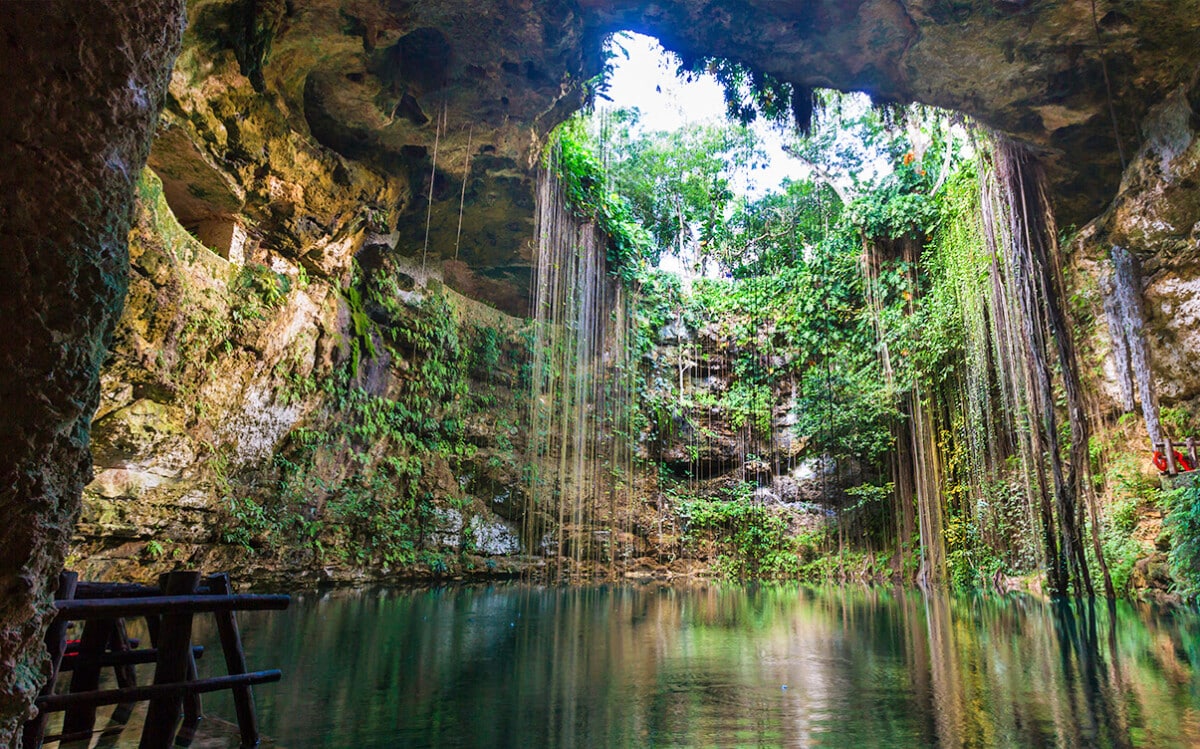
Cancun is packed with tropical attractions, making it one of the most popular destinations in the world for tourists, especially American tourists, during spring break.
Among the many different attractions you can find in Cancun are the ever-popular cenotes. What are they, why are they so impressive, and how can you visit them on a trip to Cancun?
What are Cenotes?
The word cenote, pronounced “seh-no-tay” is a Spanish version of the Mayan word D’zonot/Ts’onot, and it’s a geographic term used to describe a particular kind of land and water formation.
Basically, a cenote is an underground cave or sinkhole filled with water. A hole in the ground with water in the bottom and land over the top is just a cave; when the top of that cave collapses in, exposing the water to the open air, it becomes a young cenote. Over time, the edges of the hole further collapse, forming a mature cenote. If enough land collapses and the water dries up, it becomes a dry cenote. A dry cenote isn’t all that impressive, though, so we’re only going to be talking about the young and mature cenotes today.
Cenotes, many generations ago, were a place of worship and were of great cultural importance to the Yucatan Mayan people. They were a source of fresh water, but they were also considered to be entrances to the underworld. Explorers have even found pottery, jade artifacts, gold, incense, and even human remains in the bottoms of some cenotes.
These days, the religious importance has waned, but the array of cenotes in the Yucatan peninsula still hold cultural importance as tourist destinations, and as water sources throughout the area.
How are Cenotes Formed?
Cenotes form whenever there’s some kind of underground erosion or shifting that creates a cavity or cave filled with air. Cenotes in the Yucatan are actually a long-term result of the asteroid impact that killed the dinosaurs; they form in pockets left from erosion around the ring of the crater.
Every cenote is unique. Some of them started as erosion pockets in limestone. Others were networks of caves that, over time, collapsed into distinct holes. There are also many geographic features across the peninsula that were cenotes thousands of years ago, but have since dried up and filled in.
Where Are Cenotes Located?
To many people, cenotes are synonymous with either Cancun specifically or the Yucatan peninsula in general. Most of the cenotes in the world are found in that area, but there are others elsewhere in the world. Since a cenote is just a geographic feature, anywhere caves with water in them form, a cenote can also form. There are known cenotes in other countries besides Mexico’s Yucatan, such as nearby areas of Belize. There are also further afield cenotes, like those found in Australia, the USA, Zimbabwe, Canada, and the Dominican Republic.
In most places, though, you’ll find one cenote, or maybe a few of them in an area as part of one cave system that mostly collapsed. Only in the Yucatan can you find hundreds of cenotes in one concentrated area, again due to that ancient asteroid.
How Deep are Cenotes?
Cenotes are holes in the ground filled with water, which means they’re fantastic places for you to dive and see the underwater world in a unique, evolving ecosystem. How deep down do they go?
Well, the answer varies. Some cenotes are barely more than puddles. Most are around 30-50 feet deep, around 4-8x as deep as the deep end of an Olympic swimming pool. Some are much deeper, at 150 meters. The deepest known cenote, named Zacaton, was measured with a submersible robot and was found to be a whopping 319 meters deep. That’s almost as deep as the Empire State Building is tall!
Obviously, you won’t be going that deep. Professional divers rarely go that deep and need extensive preparations to do so. Tourists and adventurers like us stick to the shallower cenotes and stay near the surface.
Are Cenotes Dangerous?
Almost certainly, yes, at the very least, because they’re pools of water. Any pond, lake, cenote, sea, or ocean swimming carries with it inherent risks. That said, they have more in common with swimming pools than with ocean swimming. You don’t have to worry about things like rip currents or waves.
Cenotes aren’t necessarily any more dangerous than a swimming pool, but some of them can be worse than others. For example, some cenotes have rocky overhangs submerged under the water; if you’re exploring via scuba diving and end up under one, there’s no clear route to the surface. And, of course, the deeper you go, the more danger you’re in.
Otherwise, there aren’t particularly any dangers in cenotes. They aren’t full of man-eating crocodiles or piranhas looking to strip the flesh from your bones. There are animals in and around cenotes, but they tend to be scared off when a tour group comes crashing in and don’t generally bother humans.
What to Know to Visit the Cenotes in Cancun
Since the cenotes are very important culturally, as water sources, and as tourist attractions, the local government wants to keep them in as pristine a condition as possible. That means there’s a lot to know and a lot of rules to follow when you visit. Here are some of the more important things to be aware of ahead of time.
Sunscreen is prohibited. When you’re spending time in the Yucatan, in and around Cancun, you’re going to be exposed to tropical sunlight. It’s good and recommended to wear sunscreen whenever you are staying on dry land. However, since the ecosystems of the cenotes are very unique and very fragile, even eco-friendly or reef-safe sunscreens can leave chemical residues that damage them over time. Most cenotes you can visit have signs telling you not to wear sunscreen.
Fortunately, if you did happen to put on sunscreen – or makeup, or other cosmetics – the more popular cenotes generally have public showers specifically so you can wash off before going swimming. Not all cenotes have these showers – the more out-of-the-way cenotes don’t expect tourists the way the more popular ones do – so be prepared for wherever you’re headed.
Be wary of disease. The cenotes aren’t controlled pools. Occasionally, there can be various issues with the water, including e.coli infections, which have come and gone with the seasons. Before taking a dip in any of the cenotes, make sure there aren’t warnings about harmful bacteria in them.
Pick the right cenotes. There are, no joke, thousands of cenotes throughout Mexico and the Yucatan peninsula. Obviously, they run a wide range; some are little more than muddy puddles or narrow pillars of water that barely look like anything. Others are huge, gorgeous caverns with overhangs, crystal-clear waters, and a unique charm. Still others were that, but now are full of tourists and surrounded by shops and infrastructure.
We’ll give you some idea of the best cenotes to visit a little later in this post, but feel free to do your own research, and don’t be afraid to go off the beaten path. There are some gorgeous cenotes in the wilderness where you need a local guide, not a commercial tour, to visit them. Is it worth the trek? That’s for you to decide.
Bring the right supplies. Some of the larger and more popular cenotes have shops and restaurants around them. More have little more than some signage, marked trails, and a shower set up for rinsing before and after your dip. Still others are completely natural. The supplies you bring will make all the difference in how well you enjoy your trip.
- Swimming gear. Swimsuits are a must if you plan to take a dip in the cenotes you visit, and really, why would you visit a water hole if not to take the plunge? Snorkel and even scuba gear can also be a good idea for certain cenotes, though you may need a guide or even permission before diving, depending on where you go.
- Sun protection. We’ve already mentioned that sunscreen is prohibited in the cenotes, but you’re still going to be facing the tropical sun in the Yucatan, and that means you need some kind of protection. Lightweight, thin long sleeves, sun hats, sunglasses, and other protection are all well advised.
- Food. Most cenotes don’t have much or any infrastructure, and only a few have nearby snack bars or restaurants – or even full resorts – so if you’re planning to visit any but the most well-kept cenotes, bring your own snacks. Don’t forget to pack out any refuse!
- Money. Cash is king; you can use a credit card when you’re in Cancun itself or on a resort, but if you’re out in the cenotes, you’re more likely to need cash for admission. Most cenotes charge you 200-400 pesos per person, though it can vary a lot.
There’s plenty more to bring, of course, but we’re not covering a whole trip to Cancun here, just the trek out to the cenotes. Good shoes, photography gear, and a local guide; plan what you need.
Is Drone Photography Allowed in the Cenotes?
Almost certainly not.
First of all, individual cenotes have rules against drone flying to prevent lost drones plunging into the depths and polluting the waters. The more compelling reason, though, is Mexican law; you are prohibited from operating a drone in Mexico if you are not a citizen. Now, sure, you could try to sneak one in and fly it over a remote cenote, but do you really want to risk an encounter with Mexican law enforcement?
Do You Need a Tour to Visit the Cenotes in Cancun?
Nope! A few cenotes are restricted to the public, a lot of cenotes are gated and charge admission, and there are a ton of cenotes in the jungle to explore if you’re more comfortable further from civilization.
That said, if all you’re going on is a map, you run a lot of risks. The last thing you want to do is get lost or spend a lot of time hiking out to a cenote that really isn’t worth the trip. All of the best cenotes are well-explored already.
Some of the cenote tours can be a good option if you want a more guided experience, or with shuttle service to and from the cenotes, or even pre-arranged restaurants and other tour features. There are good reasons to give it a try, so don’t be afraid to shop around.
Another option is to go on a self-guided tour. A famous one is La Ruta de los Cenotes, which is a 20 km route through over a dozen cenotes, ranging from almost theme park levels of construction to little more than an attendant and a rope.
When to Visit the Cenotes in Cancun
Cenotes are very seasonal, so planning your trip appropriately is extremely important. During the dry season, from November on, some cenotes suffer algae blooms and are unpleasant or even dangerous to swim in. Others are still fine. The wet season, from June through October, can cause your visit to be plagued with more rainfall. It tends to be hotter through the end of summer, but it reduces the algae.
There’s not necessarily a bad time to visit the cenotes, other than maybe spring break if you don’t want to compete with thousands of college kids.
What are the Best Cenotes in Cancun?
It’s hard to call any cenotes “the best” because different people will have different preferences. There are so many, and there’s something for everyone; it’s just a matter of finding them.
Some more popular and interesting cenotes you can check out include:
- Lu’um Cenote
- Zapote Cenote EcoPark
- Iik’ Cenote
- La Noria Cenote
- Ha’ Cenote
- Cenote Azul
- K’aak Cenote
- Cenote Cristalino
- Cenote Zacil-Ha
- Cenote Calavera
- Cenote Dos Ojos
- Cenote Jardin del Eden
- Cenote Tajma Ha
- Cenote El Pit
With over 6,000 cenotes throughout Mexico, most of them centered around the Yucatan, this list only scratches the barest bit of the surface.
Have you ever taken a trip through the cenotes? Is it on your bucket list? Tell us all about it in the comments!
You may also enjoy:
